Beta Pictoris b
Beta Pictoris b (abbreviated as β Pic b) is an exoplanet orbiting the young debris disk A-type main sequence star Beta Pictoris located approximately 63 light-years (19.4 parsecs, or 6×1014 km) away from Earth in the constellation of Pictor. It has a mass around 13 Jupiter masses and a radius around 46% larger than Jupiter's. It orbits at 9 AU from Beta Pictoris, which is about 3.5 times farther than the orbit of Beta Pictoris c.[4] It orbits close to the plane of the debris disk orbiting the star, with a low eccentricity and a period of 20–21 years.
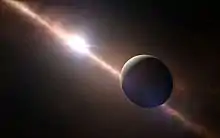 Artist's impression of Beta Pictoris b. The debris disk around the parent star can be seen. | |
| Discovery | |
|---|---|
| Discovered by | Lagrange et al. |
| Discovery site | Very Large Telescope |
| Discovery date | November 18, 2008 |
| Direct imaging | |
| Orbital characteristics[1] | |
| 10.018+0.082 −0.076 AU | |
| Eccentricity | 0.106+0.007 −0.006 |
| 23.593+0.248 −0.209 yr | |
| Inclination | 89.009°±0.012° |
| 31.774°+0.008° −0.009° | |
| 2448022.339+15.635 −24.710 | |
| 21.835°+4.099° −4.044° | |
| Semi-amplitude | 78.791+15.672 −14.126 m/s |
| Star | Beta Pictoris |
| Physical characteristics | |
Mean radius | 1.46±0.01[2][note 1] RJ |
| Mass | 11.729+2.337 −2.135[1] MJ |
| 8.1 h[3] | |
| Temperature | 1,724 K (1,451 °C; 2,644 °F) ±15 K (15 °C; 27 °F)[2][note 1] |
Physical characteristics
Mass, radius and temperature
Beta Pictoris b is a super-Jupiter, an exoplanet that has a radius and mass greater than that of the planet Jupiter. It has a temperature of 1,724 K (1,451 °C; 2,644 °F), most likely due to its dusty atmosphere and mass (normally it would be much colder). It has a mass of between 9 and 13 Jupiter masses (MJ),[5] and a radius of 1.46 RJ.[2] In 2018, a study directly measured the astrometric perturbation of Beta Pictoris by Beta Pictoris b, one of the first examples of an exoplanet being measured directly by its astrometric perturbation. Its mass was directly measured as 11±2 MJ.[5]
Host star
The planet orbits an (A-type) star named Beta Pictoris. The star has a mass of 1.75 solar masses (M☉) and a radius of 1.8 solar radii (R☉). It has a surface temperature of 8056 K and is 12 million years old. In comparison, the Sun is about 4.6 billion years old[6] and has a surface temperature of 5778 K.[7] It is slightly metal-rich, with a metallicity ([Fe/H]) of 0.06, or 112% of that found in the Sun.[8] Its luminosity (L☉) is 8.7 times that of the Sun.
The star's apparent magnitude, or how bright it appears from Earth's perspective, is 3. Therefore, it can be seen with the naked eye.
Orbit
Beta Pictoris b orbits its host star every 21 years at a distance of 9.2 AU (about the same as Saturn's distance, which is about 9.55 AU). It receives 11% of the amount of sunlight that Earth does from the Sun.[9]
Planetary rotation
In 2014, the rotation period of Beta Pictoris b was calculated from the broadening of its carbon monoxide infrared absorption line. This makes it, as of 2015, the first extrasolar planet to have its rotation rate measured.
With a rotation period of 8.1 hours, it is the fastest-spinning planet known.[3][10][11] Its rotation period is faster than that of Jupiter, which has a rotation period of around 10 hours.
The rotation axis of the planet is well aligned to the axis of the parent star and debris disk, with misalignment measured to be 3±5 degrees in 2020.[12]
Discovery
The planet was discovered on November 18, 2008 by Anne-Marie Lagrange et al., using the NACO instrument on the Very Large Telescope at Cerro Paranal in northern Chile.[13] This planet was discovered using the direct imaging technique, using reference star differential imaging. The discovery image was taken in 2003, but the planet was not detected when the data were first reduced. A re-reduction of the data in 2008 using modern image processing tools revealed the faint point source now known to be a planet.
Further studies
Follow-up observations performed in late 2009 and early 2010 using the same instrument recovered and confirmed the planet, but on the opposite side of the star. These findings were published in the journal Science[14] and represented the closest orbiting planet to its star ever imaged. Observations performed in late 2010 and early 2011 allowed scientists to establish an inclination angle of the planet's orbit of 88.5 degrees, nearly edge-on. The location of the planet was found to be approximately 3.5 to 4 degrees tilted from the main disk in this system, indicating that the planet is aligned with the warped inner disk in the Beta Pictoris system.[15]
The first study of the spectral energy distribution of the planet was published in July 2013.[16] This study shows detections at 1.265, 1.66, 2.18, 3.80, 4.05 and 4.78 µm demonstrating that the planet has a very dusty and/or cloudy atmosphere. The SED is consistent with that of an early L dwarf, but with a lower surface gravity. The effective temperature is constrained to 1700±100 K and the surface gravity to log g = 4.0±0.5. A second study, published in September 2013,[17] provided a new detection at 3.1 µm obtained at the Gemini Observatory along with a reanalysis of previous data. They found the planet to be overluminous in the mid-infrared 3.1 µm band compared to models of early L dwarfs. Models incorporating small dust particles and thick clouds provided the best fit to the SED. The effective temperature is constrained to 1600+50
−25 K and the surface gravity to log g = 3.8±0.02. This fit corresponds to a planet radius of 1.65 times that of Jupiter, arguing that Beta Pictoris b may be younger than its host star (finished forming at 5 Ma).
In 2015, a short video was made from direct images of Beta Pictoris b taken by the Gemini Planet Imager over the course of about two years showing a time-lapse of the planet orbiting around its parent star.[18] It may have been responsible for a transit-like event observed in 1981.
In 2018, the PicSat cubesat was launched in a mission to image the planet Beta Pictoris b transiting its host star Beta Pictoris.
As of 2022, the orbital parameters and mass of Beta Pictoris b have been measured using a combination of data from radial velocity, astrometry, and imaging,[19] showing that it is about 11.7 times the mass of Jupiter with a semi-major axis of about 10 AU and an orbital period of about 23.6 years.[1]
Gallery
 Beta Pictoris b time-lapse.[20]
Beta Pictoris b time-lapse.[20]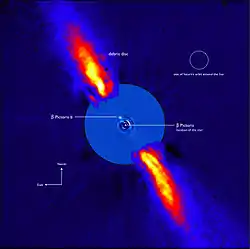 An annotated view of the Beta Pictoris system.
An annotated view of the Beta Pictoris system.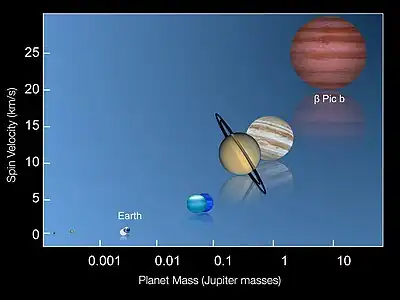 Equatorial spin velocity vs mass for planets comparing Beta Pictoris b to the Solar System planets.
Equatorial spin velocity vs mass for planets comparing Beta Pictoris b to the Solar System planets.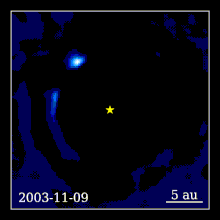 The motion of Beta Pictoris b. The orbital plane is viewed side-on; the planet is not moving towards the star.
The motion of Beta Pictoris b. The orbital plane is viewed side-on; the planet is not moving towards the star.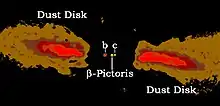 Artistic rendering of the Beta Pictoris system, showing the accretion disk, and the two planets.
Artistic rendering of the Beta Pictoris system, showing the accretion disk, and the two planets.
Notes
- The stated uncertainties are statistical errors only, and do not incorporate any uncertainty on the evolutionary models
References
- Feng, Fabo; Butler, R. Paul; et al. (August 2022). "3D Selection of 167 Substellar Companions to Nearby Stars". The Astrophysical Journal Supplement Series. 262 (21): 21. arXiv:2208.12720. Bibcode:2022ApJS..262...21F. doi:10.3847/1538-4365/ac7e57. S2CID 251864022.
- Chilcote, Jeffrey; et al. (2017). "1–2.4μm Near-IR Spectrum of the Giant Planet β Pictoris b Obtained with the Gemini Planet Imager". The Astronomical Journal. 153 (4). 182. arXiv:1703.00011. Bibcode:2017AJ....153..182C. doi:10.3847/1538-3881/aa63e9. S2CID 23669676.
- "Length of Exoplanet Day Measured for First Time / VLT measures the spin of Beta Pictoris b". April 30, 2014.
- Lagrange, A.-M.; Meunier, Pascal Rubini; Keppler, Miriam; Galland, Franck; et al. (August 19, 2019). "Evidence for an additional planet in the β Pictoris system". Nature Astronomy. 3 (12): 1135–1142. Bibcode:2019NatAs...3.1135L. doi:10.1038/s41550-019-0857-1. S2CID 202126059. Retrieved August 20, 2019.
- Snellen, I. A. G.; Brown, A. G. A. (2018). "The mass of the young planet Beta Pictoris b through the astrometric motion of its host star". Nature Astronomy. 2 (11): 883–886. arXiv:1808.06257. Bibcode:2018NatAs...2..883S. doi:10.1038/s41550-018-0561-6. S2CID 118896628.
- Fraser Cain (September 16, 2008). "How Old is the Sun?". Universe Today. Retrieved February 19, 2011.
- Fraser Cain (September 15, 2008). "Temperature of the Sun". Universe Today. Retrieved February 19, 2011.
- Gray, R. O.; et al. (2006). "Contributions to the Nearby Stars (NStars) Project: Spectroscopy of Stars Earlier than M0 within 40 pc—The Southern Sample". The Astronomical Journal. 132 (1): 161–170. arXiv:astro-ph/0603770. Bibcode:2006AJ....132..161G. doi:10.1086/504637. S2CID 119476992.
- http://www.hpcf.upr.edu/~abel/phl/hec_plots/hec_orbit/hec_orbit_beta_Pic_b.png
- Cowen, R. (April 30, 2014). "First exoplanet seen spinning". Nature. doi:10.1038/nature.2014.15132. S2CID 123849861.
- Snellen, I. A. G.; Brandl, B. R.; De Kok, R. J.; Brogi, M.; Birkby, J.; Schwarz, H. (2014). "Fast spin of the young extrasolar planet β Pictoris b". Nature. 509 (7498): 63–65. arXiv:1404.7506. Bibcode:2014Natur.509...63S. doi:10.1038/nature13253. PMID 24784216. S2CID 4472993.
- Kraus, Stefan; Le Bouquin, Jean-Baptiste; Kreplin, Alexander; Davies, Claire L.; Hone, Edward; Monnier, John D.; Gardner, Tyler; Kennedy, Grant; Hinkley, Sasha (2020), "Spin–Orbit Alignment of the β Pictoris Planetary System", The Astrophysical Journal, 897 (1): L8, arXiv:2006.10784, Bibcode:2020ApJ...897L...8K, doi:10.3847/2041-8213/ab9d27, S2CID 219956049
- Lagrange, A.-M.; Gratadour, D.; Chauvin, G.; Fusco, T.; Ehrenreich, D.; Mouillet, D.; Rousset, G.; Rouan, D.; Allard, F.; Gendron, É.; Charton, J.; Mugnier, L.; Rabou, P.; Montri, J.; Lacombe, F. (2009). "A probable giant planet imaged in the β Pictoris disk". Astronomy and Astrophysics. 493 (2): L21–L25. arXiv:0811.3583. Bibcode:2009A&A...493L..21L. doi:10.1051/0004-6361:200811325. ISSN 0004-6361. S2CID 16548235.
- Lagrange, A.- M.; Bonnefoy, M.; Chauvin, G.; Apai, D.; Ehrenreich, D.; Boccaletti, A.; Gratadour, D.; Rouan, D.; Mouillet, D.; Lacour, S.; Kasper, M. (2010). "A Giant Planet Imaged in the Disk of the Young Star Pictoris". Science. 329 (5987): 57–59. arXiv:1006.3314. Bibcode:2010Sci...329...57L. doi:10.1126/science.1187187. ISSN 0036-8075. PMID 20538914. S2CID 5427102.
- Chauvin, G.; Lagrange, A.-M.; Beust, H.; Bonnefoy, M.; Boccaletti, A.; Apai, D.; Allard, F.; Ehrenreich, D.; Girard, J. H. V.; Mouillet, D.; Rouan, D. (2012). "Orbital characterization of the β Pictoris b giant planet". Astronomy & Astrophysics. 542: A41. arXiv:1202.2655. Bibcode:2012A&A...542A..41C. doi:10.1051/0004-6361/201118346. ISSN 0004-6361. S2CID 62806093.
- Bonnefoy, M.; Boccaletti, A.; Lagrange, A.-M.; Allard, F.; Mordasini, C.; Beust, H.; Chauvin, G.; Girard, J. H. V.; Homeier, D.; Apai, D.; Lacour, S.; Rouan, D. (2013). "The near-infrared spectral energy distribution ofβPictoris b". Astronomy & Astrophysics. 555: A107. arXiv:1302.1160. Bibcode:2013A&A...555A.107B. doi:10.1051/0004-6361/201220838. ISSN 0004-6361. S2CID 54014134.
- Currie, Thayne; et al. (2013). "A Combined Very Large Telescope and Gemini Study of the Atmosphere of the Directly Imaged Planet, β Pictoris b". The Astrophysical Journal. 776 (1). 15. arXiv:1306.0610. Bibcode:2013ApJ...776...15C. doi:10.1088/0004-637X/776/1/15. S2CID 118825345.
- Now, Astronomy. "Watching an exoplanet in motion around a distant star | Astronomy Now". Retrieved September 29, 2015.
- Lacour, S.; et al. (2021). "The mass of β Pictoris c from β Pictoris b orbital motion". Astronomy & Astrophysics. 654: L2. arXiv:2109.10671. Bibcode:2021A&A...654L...2L. doi:10.1051/0004-6361/202141889. S2CID 237592885.
- "Stunning Exoplanet Time-lapse". www.eso.org. Retrieved November 12, 2018.